The Conditioning Hair Treatments Market is expected to record a valuation of USD 8,702.1 million in 2025 and USD 18,502.5 million in 2035, with an increase of USD 9,800.4 million, which equals a growth of 193% over the decade. The overall expansion represents a CAGR of 7.8% and a 2X increase in market size.
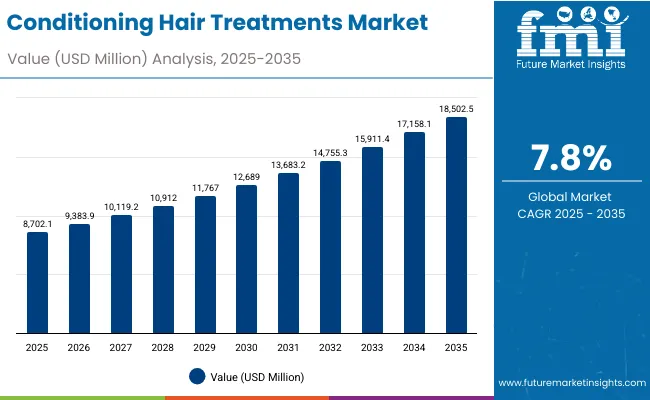
Conditioning Hair Treatments Market Key Takeaways
| Metric | Value |
|---|---|
| Conditioning Hair Treatments Market Estimated Value (2025E) | USD 8,702.1 million |
| Conditioning Hair Treatments Market Forecast Value (2035F) | USD 18,502.5 million |
| Forecast CAGR (2025 to 2035) | 7.8% |
During the first five-year period from 2025 to 2030, the market increases from USD 8,702.1 million to USD 12,689.0 million, adding USD 3,986.9 million, which accounts for 41% of the total decade growth. This phase records steady adoption of keratin-based formulations, salon-exclusive protein repair masks, and deep-conditioning creams, driven by consumer demand for moisture retention and damage repair. Short-range scanners dominate this period as they cater to over 68% of industrial applications requiring micron-level accuracy.
The second half from 2030 to 2035 contributes USD 5,813.5 million, equal to 59% of total growth, as the market jumps from USD 12,689.0 million to USD 18,502.5 million. This acceleration is powered by widespread deployment of AI-integrated hair analysis tools, ingredient innovation such as amino acid and silicone blends, and the expansion of professional salon treatment lines. Long-range and mid-range scanners together capture a larger share above 32% by the end of the decade. Software-led analytics and cloud-based personalization systems add recurring revenue, increasing the software share beyond 35% in total market value.
From 2020 to 2024, the Conditioning Hair Treatments Market grew steadily from USD 6,100 million to USD 8,702.1 million, driven by hardware-centric adoption of advanced conditioning formulations and professional-grade salon solutions. During this period, the competitive landscape was dominated by major brands controlling nearly 70% of global revenue, with leaders such as L’Oréal Professionnel, Kerastase, and Wella focusing on salon-exclusive hardware treatments like deep conditioners and repair masks. Competitive differentiation relied on ingredient innovation, efficacy, and product format versatility, while software-driven hair diagnostics remained a secondary offering in premium segments. Service-based treatment models such as subscription salon care accounted for less than 10% of the total market value.
Demand for Conditioning Hair Treatments will expand to USD 18,502.5 million by 2035, and the revenue mix will shift as software and service components grow to over 35% share. Traditional hardware leaders face rising competition from digital-first players offering AI-driven scalp analysis, cloud-based personalization, and app-linked diagnostic systems. Major brands are pivoting toward hybrid models, integrating customized treatment recommendations and data-based formulation adjustments to retain relevance. Emerging entrants specializing in AR/VR consultation tools and personalized care platforms are gaining share, as the competitive advantage shifts from product innovation alone to ecosystem strength, scalability, and recurring revenue streams.
Market growth is driven by increasing consumer focus on repairing hair damage caused by chemical treatments, pollution, and heat styling. Demand for deep conditioners, protein-based repair creams, and keratin-infused products is accelerating, particularly in urban markets. Professional salons and home users alike are prioritizing solutions that restore hair strength and shine. The preference for high-performance, salon-grade formulations is also expanding the premium product segment, supporting consistent revenue growth across global and regional brands.
The market is further expanding due to digital innovation in product personalization and smart diagnostics. AI-driven scalp analysis tools and cloud-based customization platforms enable brands to create tailored conditioning treatments for individual hair needs. E-commerce platforms and social media marketing are amplifying brand reach and consumer engagement. The integration of professional salon services with at-home care routines has increased recurring purchases, while growing awareness of ingredient transparency and sustainability continues to shape consumer preferences and product innovation.
The Conditioning Hair Treatments Market is segmented by product type, key ingredients, hair concern, distribution channel, end user, and region. By product type, the market includes deep conditioners, leave-in treatments, hair masks, and protein-based repair creams, forming the core of both professional and home-use hair repair systems. Key ingredients such as keratin, argan oil, coconut oil, silicones, and amino acids drive performance differentiation and consumer preference.
Based on hair concern, segmentation includes dry and damaged hair, color-treated hair, frizz control, and split-end repair. Distribution channels comprise supermarkets and hypermarkets, e-commerce platforms, salons/professional supply stores, and pharmacies/drugstores. End users are categorized into women, men, and professional salons, reflecting both retail and institutional demand. Regionally, the market spans North America, Europe, East Asia, South Asia & Pacific, Latin America, and the Middle East & Africa, with strong growth momentum led by India, China, and Japan.
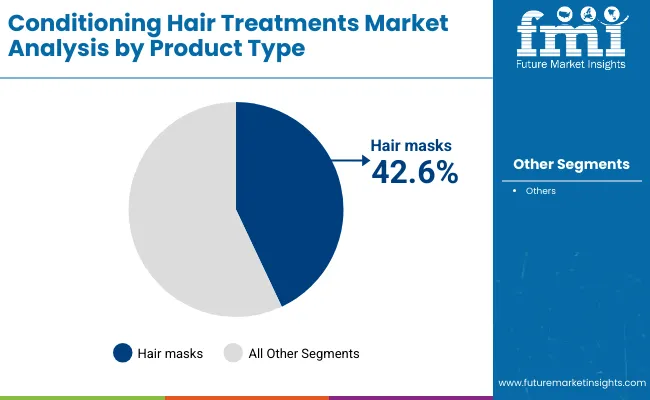
| Product Type | Value Share% 2025 |
|---|---|
| Hair masks | 42.6% |
| Others | 57.4% |
The hair masks segment is projected to contribute 42.6% of the Conditioning Hair Treatments Market revenue in 2025, maintaining its lead as the dominant product category. This growth is driven by the rising preference for intensive repair and nourishment treatments formulated with keratin, argan oil, and amino acids. Hair masks are widely adopted in both salon and at-home care routines due to their restorative properties that address dryness, color damage, and frizz.
Increasing consumer awareness about deep-conditioning benefits, coupled with innovations in protein-based and moisture-locking formulations, is propelling market expansion. Premium and professional-grade hair masks are gaining traction across urban markets, reinforcing their role as the backbone of the Conditioning Hair Treatments product landscape.
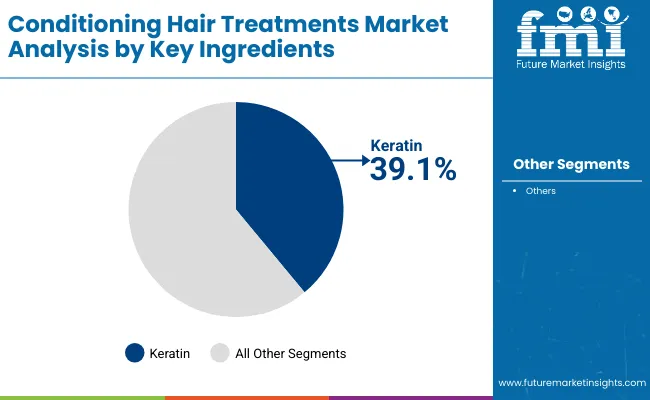
| Key Ingredients | Value Share% 2025 |
|---|---|
| Keratin | 39.1% |
| Others | 60.9% |
The keratin-based formulations segment is forecasted to hold 39.1% of the Conditioning Hair Treatments Market share in 2025, driven by its strong role in repairing and strengthening damaged hair. Keratin is favored for its ability to rebuild the hair’s natural structure, reduce frizz, and enhance smoothness, making it a key ingredient in both salon and retail conditioning products. Its compatibility with color-treated and chemically processed hair has expanded its use across premium product lines.
The segment’s growth is further fueled by the introduction of hydrolyzed keratin variants that deliver better absorption and long-lasting results. As consumers increasingly seek professional-grade, restorative care solutions, keratin remains the cornerstone ingredient shaping innovation and demand in the global Conditioning Hair Treatments Market.
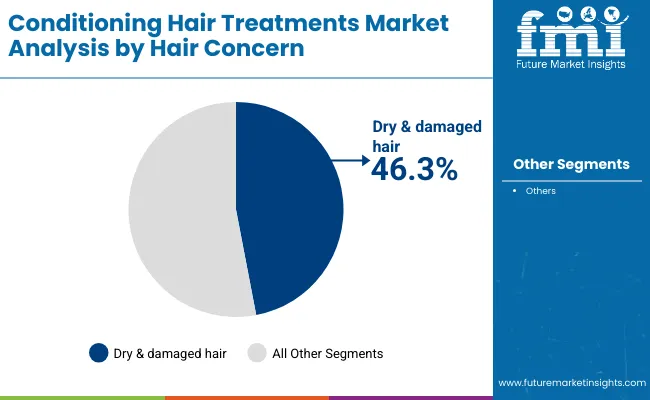
| Hair Concern | Value Share% 2025 |
|---|---|
| Dry & damaged hair | 46.3% |
| Others | 53.7% |
The dry & damaged hair segment is projected to account for 46.3% of the Conditioning Hair Treatments Market revenue in 2025, establishing it as the leading hair concern category. This dominance is driven by the rising prevalence of hair damage caused by heat styling, chemical treatments, and environmental stressors. Consumers are increasingly seeking intensive conditioning solutions that restore moisture, smoothness, and elasticity.
Products formulated with keratin, argan oil, and amino acids are witnessing strong adoption due to their reparative and protective benefits. The segment’s growth is also supported by expanding professional salon treatments targeting repair and nourishment. With growing awareness of preventive hair care and hydration-focused regimens, the dry & damaged hair category is expected to remain at the forefront of market demand through 2035.
Rising Demand for Intensive Repair and Nourishment Solutions
The market is primarily driven by increasing consumer focus on hair repair and deep conditioning treatments addressing dryness, chemical damage, and frizz. The growing use of styling tools, coloring products, and environmental stress has heightened the demand for nutrient-rich formulas containing keratin, argan oil, and amino acids. Premium hair masks and salon-grade treatments are expanding in both professional and home care segments. Brands are responding with advanced formulations that provide visible restoration and long-lasting smoothness, propelling consistent revenue growth across urban and semi-urban markets worldwide.
Expansion of E-commerce and Professional Salon Networks
The rapid rise of e-commerce platforms and digital retailing has made conditioning hair treatments more accessible to global consumers. Online tutorials, influencer marketing, and virtual hair diagnostics are increasing brand engagement and consumer education. Simultaneously, professional salon chains are expanding in emerging economies, offering premium conditioning services and customized treatment plans. The hybrid integration of salon expertise with at-home maintenance kits is driving repeat purchases. This dual-channel growth structure combining convenience, personalization, and expert care is creating sustainable long-term demand for conditioning treatments across diverse consumer demographics.
High Product Pricing and Ingredient Sensitivity Concerns
The market faces challenges related to high product pricing, especially in the premium and salon-grade categories. Advanced formulations featuring keratin, peptides, or silicone-free alternatives are costly to manufacture, limiting affordability for mass consumers. Moreover, concerns over ingredient sensitivity, such as protein overload or allergic reactions from specific oils and silicones, deter certain user groups. The lack of standardized ingredient disclosure and regulatory clarity in some regions adds complexity to brand positioning. These factors collectively restrict product penetration in price-sensitive and health-conscious markets.
Integration of AI-driven Hair Diagnostics and Personalization Platforms
A defining trend in the Conditioning Hair Treatments Market is the rise of AI-based diagnostics and personalized formulation systems. Brands are integrating digital scalp analyzers, mobile apps, and cloud-based data tools to assess individual hair conditions and recommend tailored treatments. This technology enables real-time customization, product pairing, and progress tracking for consumers. The shift from generic products to data-driven personalization is enhancing customer satisfaction and loyalty. As smart diagnostics converge with ingredient innovation, brands offering hybrid digital-physical care ecosystems are expected to dominate the premium segment over the next decade.
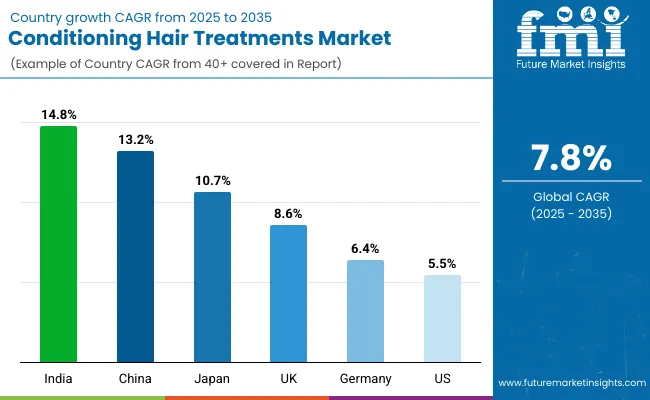
| Countries | Estimated CAGR (2025 to 2035) |
|---|---|
| China | 13.2% |
| USA | 5.5% |
| India | 14.8% |
| UK | 8.6% |
| Germany | 6.4% |
| Japan | 10.7% |
The global Conditioning Hair Treatments Market displays significant regional variation, shaped by evolving consumer routines, salon infrastructure maturity, and the premiumization of beauty and wellness sectors. Asia-Pacific stands out as the fastest-growing region, led by India (14.8%) and China (13.2%), where rising disposable incomes, urbanization, and expanding professional salon chains drive strong uptake of conditioning masks and leave-in treatments. Growing awareness of hair health and the influence of K-beauty and J-beauty trends are accelerating adoption across East Asia, including Japan (10.7%), which emphasizes premium, ingredient-focused formulations.
Europe, led by the UK (8.6%) and Germany (6.4%), maintains steady growth, supported by demand for sulfate-free, vegan, and silicone-free conditioners driven by sustainability consciousness and strict cosmetic regulations. The region’s mature salon ecosystem continues to promote keratin-based and botanical treatments. Meanwhile, North America, with the USA growing at 5.5% CAGR, shows moderate expansion driven by the rise of clean-label products, e-commerce distribution, and data-backed personalized care. Digital diagnostics, subscription-based product models, and hybrid professional-retail brands are further shaping demand. Collectively, these factors position Asia-Pacific as the primary growth hub, while Europe and North America sustain value-led innovation in the global Conditioning Hair Treatments Market.
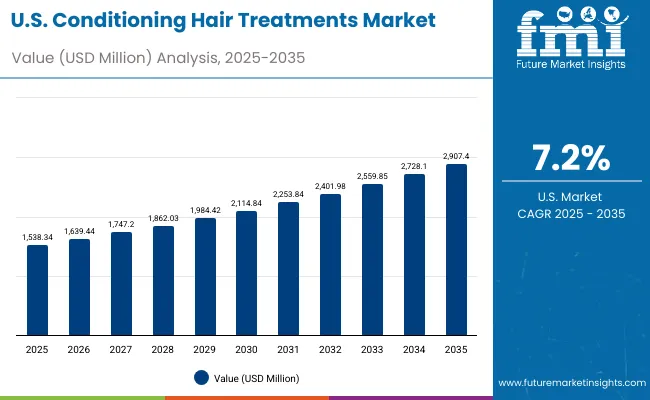
| Year | USA Conditioning Hair Treatments Market (USD Million) |
|---|---|
| 2025 | 1538.34 |
| 2026 | 1639.44 |
| 2027 | 1747.20 |
| 2028 | 1862.03 |
| 2029 | 1984.42 |
| 2030 | 2114.84 |
| 2031 | 2253.84 |
| 2032 | 2401.98 |
| 2033 | 2559.85 |
| 2034 | 2728.10 |
| 2035 | 2907.40 |
The Conditioning Hair Treatments Market in the United States is projected to grow at a CAGR of 7.2%, led by expanding consumer preference for premium hair repair and nourishment solutions. Growth is supported by rising demand for keratin-based and protein-rich repair creams, particularly in urban and professional salon environments. The popularity of leave-in treatments and deep-conditioning masks continues to rise due to convenience and visible results. E-commerce platforms and salon retail channels are amplifying brand accessibility, while product personalization and clean-label formulations are reshaping consumer expectations. The USA market is also witnessing strong adoption of hybrid salon-home care models that promote brand loyalty and recurring purchases.
The Conditioning Hair Treatments Market in the United Kingdom is expected to grow at a CAGR of 8.6%, supported by rising consumer preference for restorative and nourishing hair care routines. The trend toward clean beauty and sustainable formulations is driving demand for silicone-free, vegan, and cruelty-free conditioners. The professional salon segment continues to expand, with premium hair mask and keratin-infused treatments gaining prominence. Retail chains and e-commerce platforms are broadening accessibility, while personalization through digital diagnostics and subscription-based replenishment services is reshaping product engagement. The combination of government-backed sustainability initiatives, innovation in bio-based ingredients, and increased focus on scalp health continues to strengthen both product diversity and market maturity.
India is witnessing rapid growth in the Conditioning Hair Treatments Market, which is forecast to expand at a CAGR of 14.8% through 2035. The surge is fueled by increasing consumer awareness of hair health, urban lifestyle changes, and the expansion of professional salon networks in tier-2 and tier-3 cities. Rising disposable incomes and exposure to global beauty standards have accelerated demand for deep conditioners, keratin repair masks, and leave-in treatments. Local manufacturers are introducing affordable yet high-performance products catering to mass-market consumers, while international brands are strengthening retail and e-commerce penetration. Digital marketing, influencer-led campaigns, and the rise of men’s grooming categories are further broadening the customer base.
The Conditioning Hair Treatments Market in China is expected to grow at a CAGR of 13.2%, the highest among leading economies. This strong momentum is driven by rapid urbanization, growing middle-class spending power, and increasing demand for premium, restorative hair care products. The professional salon industry is expanding rapidly, supported by localized product innovation and international brand collaborations. Consumers are increasingly shifting toward keratin-infused, argan oil, and amino acid-based conditioners that target dryness and chemical damage. Domestic brands are also competing on affordability, offering quality treatments suited for regional climates. The influence of K-beauty and J-beauty formulations has further elevated expectations for texture, shine, and performance.
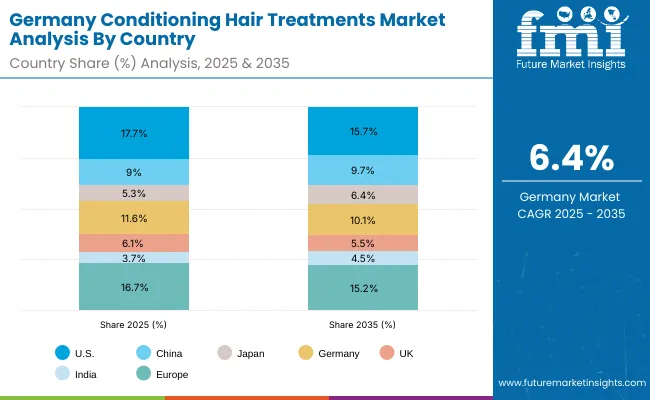
| Countries | 2025 Share (%) |
|---|---|
| USA | 17.7% |
| China | 9.0% |
| Japan | 5.3% |
| Germany | 11.6% |
| UK | 6.1% |
| India | 3.7% |
| Countries | 2035 Share (%) |
|---|---|
| USA | 15.7% |
| China | 9.7% |
| Japan | 6.4% |
| Germany | 10.1% |
| UK | 5.5% |
| India | 4.5% |
The Conditioning Hair Treatments Market in Germany is projected to grow at a CAGR of 6.4%, supported by a mature beauty care industry, strong salon infrastructure, and growing consumer preference for premium, sustainable formulations. German consumers prioritize ingredient transparency, dermatological safety, and eco-certification, driving brands to innovate with vegan, silicone-free, and organic conditioners.
The rise of professional salon treatments offering keratin repair, anti-frizz, and color-protection solutions continues to strengthen the market’s high-value segment. Moreover, domestic manufacturers are expanding their export footprint across Europe by emphasizing clean-label, recyclable packaging, and green formulation standards. Digital channels, including e-commerce and beauty subscription services, are enhancing consumer access and product discovery.
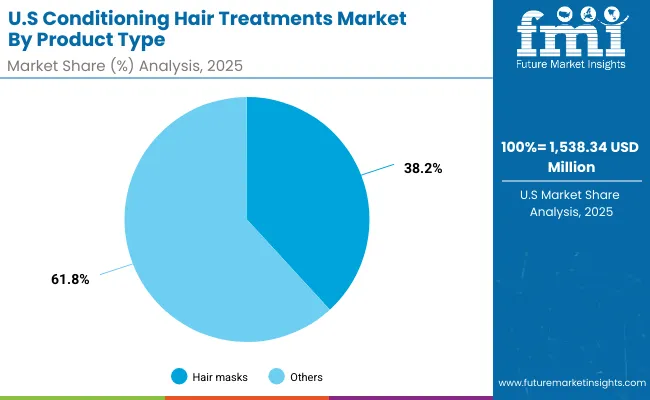
| USA By Product Type | Value Share% 2025 |
|---|---|
| Hair masks | 38.2% |
| Others | 61.8% |
The Conditioning Hair Treatments Market in the United States is projected at USD 1,538.34 million in 2025, with hair masks contributing 38.2% and other product categories, including leave-in treatments and deep conditioners, accounting for 61.8%. This balanced structure highlights strong demand for multi-functional products that combine nourishment, protection, and convenience.
The premiumization of conditioning treatments, supported by innovations in keratin and argan oil formulations, continues to drive consumer upgrades toward high-performance solutions. Additionally, digital transformation in retail through AI-based recommendations, subscription-based delivery, and virtual consultations is reshaping purchasing behavior. Clean-label, sulfate-free, and scalp-friendly conditioners are gaining rapid traction, especially among wellness-oriented consumers.
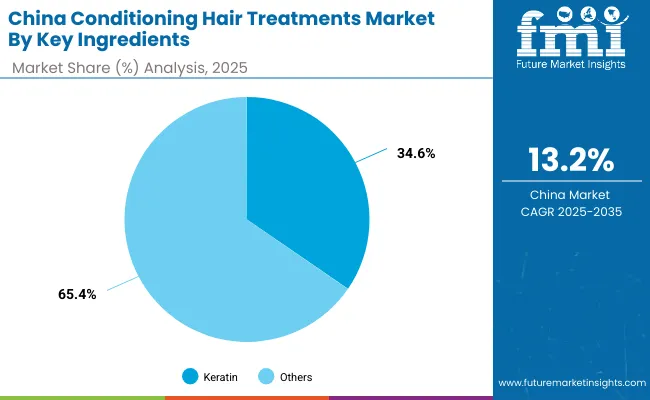
| China By Key Ingredients | Value Share% 2025 |
|---|---|
| Keratin | 34.6% |
| Others | 65.4% |
The Conditioning Hair Treatments Market in China presents strong growth opportunities, with keratin-based formulations accounting for 34.6% of total market value in 2025. This dominance reflects the country’s growing demand for high-performance, restorative hair care products among urban consumers. The expansion of salon chains, rising disposable income, and social media-driven beauty trends are key catalysts.
Domestic brands are innovating with keratin, argan oil, and amino acid complexes to meet local hair texture and climate needs. Furthermore, China’s e-commerce ecosystem led by Tmall, JD.com, and Douyin is creating new opportunities for personalized, data-driven product offerings. Collaborations between international and local brands are also accelerating the development of hybrid formulations that balance traditional herbal ingredients with advanced conditioning actives.
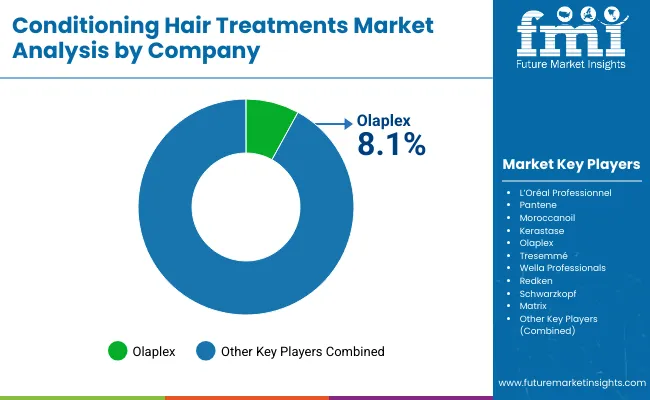
The Conditioning Hair Treatments Market is moderately fragmented, characterized by a mix of global beauty conglomerates, professional salon brands, and emerging indie innovators competing across premium and mass-market segments. Leading global players such as L’Oréal Professionnel, Wella Professionals, and Olaplex maintain a strong presence through extensive salon partnerships, premium product portfolios, and active consumer education. Their strategies emphasize formulation innovation, bond-repair technologies, and clean-beauty alignment, reinforcing dominance in the high-value segment.
Mid-sized brands such as Moroccanoil, Kerastase, and Redken continue to drive growth through professional-grade offerings and expansion into retail and e-commerce platforms. These companies leverage digital campaigns, influencer collaborations, and AI-based personalization to strengthen consumer engagement.
Emerging brands and regional specialists including Tresemmé, Matrix, and Schwarzkopf focus on affordable, accessible solutions, catering to a broader demographic through high-performance yet budget-friendly conditioners.
Competitive differentiation is shifting from ingredient claims toward complete consumer experience ecosystems, combining data-backed personalization, subscription-based care models, and sustainability-focused innovations. This evolution highlights how technology integration, ethical sourcing, and brand transparency are becoming key drivers of long-term market leadership.
Key Developments in Conditioning Hair Treatments Market
| Item | Value |
|---|---|
| Quantitative Units | USD 8,702.1 Million |
| Product Type | Deep conditioners, Leave-in treatments, Hair masks, Protein-based repair creams |
| Key Ingredients | Keratin, Argan oil, Coconut oil, Silicones, Amino acids |
| Hair Concern | Dry & damaged hair, Color-treated hair, Frizz control, Split-end repair |
| Channel | Supermarkets & hypermarkets, E-commerce, Salons/professional supply, Pharmacies/drugstores |
| End User | Women, Men, Professional salons |
| Regions Covered | North America, Europe, Asia-Pacific, Latin America, Middle East & Africa |
| Country Covered | United States, Canada, Germany, France, United Kingdom, China, Japan, India, Brazil, South Africa |
| Key Companies Profiled | L’Oréal Professionnel, Pantene, Moroccanoil, Kerastase, Olaplex, Tresemmé, Wella Professionals, Redken, Schwarzkopf, Matrix |
| Additional Attributes | Dollar sales by product type and end-use category, evolving consumer adoption trends in salon and at-home care, rising demand for portable and easy-to-apply treatments such as leave-in conditioners and hair masks, and strong growth across premium and mass segments. Sector-specific expansion is observed in professional salons, e-commerce, and retail chains, supported by ingredient innovation in keratin, argan oil, and amino acids. The market also reflects increasing software and services integration through AI-driven hair diagnostics, AR-based virtual try-ons, and digital personalization platforms. Regional trends are shaped by urbanization, income growth, and beauty digitization initiatives, while innovations in formulation delivery such as micro-encapsulation and moisture-lock technology continue to redefine performance and consumer experience. |
The global Conditioning Hair Treatments Market is estimated to be valued at USD 8,702.1 million in 2025.
The market size for the Conditioning Hair Treatments Market is projected to reach USD 18,502.5 million by 2035.
The Conditioning Hair Treatments Market is expected to grow at a 7.8% CAGR between 2025 and 2035.
The key product types in the Conditioning Hair Treatments Market are deep conditioners, leave-in treatments, hair masks, and protein-based repair creams.
In terms of application focus, the hair masks segment is projected to command a 42.6% share of the Conditioning Hair Treatments Market in 2025, driven by growing consumer preference for intensive repair and nourishment treatments formulated with keratin and natural oils.






Our Research Products

The "Full Research Suite" delivers actionable market intel, deep dives on markets or technologies, so clients act faster, cut risk, and unlock growth.

The Leaderboard benchmarks and ranks top vendors, classifying them as Established Leaders, Leading Challengers, or Disruptors & Challengers.

Locates where complements amplify value and substitutes erode it, forecasting net impact by horizon

We deliver granular, decision-grade intel: market sizing, 5-year forecasts, pricing, adoption, usage, revenue, and operational KPIs—plus competitor tracking, regulation, and value chains—across 60 countries broadly.

Spot the shifts before they hit your P&L. We track inflection points, adoption curves, pricing moves, and ecosystem plays to show where demand is heading, why it is changing, and what to do next across high-growth markets and disruptive tech

Real-time reads of user behavior. We track shifting priorities, perceptions of today’s and next-gen services, and provider experience, then pace how fast tech moves from trial to adoption, blending buyer, consumer, and channel inputs with social signals (#WhySwitch, #UX).

Partner with our analyst team to build a custom report designed around your business priorities. From analysing market trends to assessing competitors or crafting bespoke datasets, we tailor insights to your needs.
Supplier Intelligence
Discovery & Profiling
Capacity & Footprint
Performance & Risk
Compliance & Governance
Commercial Readiness
Who Supplies Whom
Scorecards & Shortlists
Playbooks & Docs
Category Intelligence
Definition & Scope
Demand & Use Cases
Cost Drivers
Market Structure
Supply Chain Map
Trade & Policy
Operating Norms
Deliverables
Buyer Intelligence
Account Basics
Spend & Scope
Procurement Model
Vendor Requirements
Terms & Policies
Entry Strategy
Pain Points & Triggers
Outputs
Pricing Analysis
Benchmarks
Trends
Should-Cost
Indexation
Landed Cost
Commercial Terms
Deliverables
Brand Analysis
Positioning & Value Prop
Share & Presence
Customer Evidence
Go-to-Market
Digital & Reputation
Compliance & Trust
KPIs & Gaps
Outputs
Full Research Suite comprises of:
Market outlook & trends analysis
Interviews & case studies
Strategic recommendations
Vendor profiles & capabilities analysis
5-year forecasts
8 regions and 60+ country-level data splits
Market segment data splits
12 months of continuous data updates
DELIVERED AS:
PDF EXCEL ONLINE
Hair Regrowth Treatments Market Size and Share Forecast Outlook 2025 to 2035
Ingrown Hair Treatments Market Analysis - Size and Share Forecast Outlook 2025 to 2035
Hair Mineral Analyzer Market Size and Share Forecast Outlook 2025 to 2035
Hair Growth Promoters / Anti-Hair Loss Agents Market Size and Share Forecast Outlook 2025 to 2035
Hair Extension Market Size and Share Forecast Outlook 2025 to 2035
Hair Bond Multiplier Market Size and Share Forecast Outlook 2025 to 2035
Conditioning Agents Market Size and Share Forecast Outlook 2025 to 2035
Hair Loss Prevention Products Market Size and Share Forecast Outlook 2025 to 2035
Hair Thinning Solutions Market Analysis - Size and Share Forecast Outlook 2025 to 2035
Hair Growth Serums Market Analysis - Size and Share Forecast Outlook 2025 to 2035
Hair Finishing Stick Market Size and Share Forecast Outlook 2025 to 2035
Hair Serum Market Size and Share Forecast Outlook 2025 to 2035
Hair Mask Market Size and Share Forecast Outlook 2025 to 2035
Hair Straightener Market Size and Share Forecast Outlook 2025 to 2035
Hair Removal Wax Pen Market Size and Share Forecast Outlook 2025 to 2035
Hair Perfume Market Size and Share Forecast Outlook 2025 to 2035
Hair Dryer Market Analysis - Size, Share, and Forecast Outlook 2025 to 2035
Hair Serums Ingredient Market Size and Share Forecast Outlook 2025 to 2035
Hair Lightening Products Market Size and Share Forecast Outlook 2025 to 2035
Haircare Supplement Market - Size, Share, and Forecast Outlook 2025 to 2035

Thank you!
You will receive an email from our Business Development Manager. Please be sure to check your SPAM/JUNK folder too.
Chat With
MaRIA